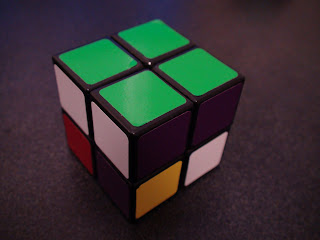2x2 - Beginners Method
Even though this cube is easier than a 3x3, it still poses a challenge to many people who try to solve it. It's small stature falsely advertises its simplicity. Solving this cube will still require the use of a few algorithms. If you already know how to solve a 3x3, you may be able to solve this cube with simply applying the 3x3 algorithms logically. The majority of this guide, other than the parity fix, is geared toward a new learner so, it will begin from the beginning.
First Off: Notation
Solving the cube requires the memorization of algorithms. An algorithm is a series of moves that move certain pieces in a desired way while keeping the rest of the cube intact. It requires an understanding of the cube notation. The notation consists of the letters: U, R, L, F, D, B. Each of these has an inverse which is designated by a ' after the letter such as U'. The original denotes a clockwise turn of the face and the inverse is a counter clockwise. U is the upper face, R is the Right, L is the Left, F is the Front, D is the bottom, and B is the back.
Step 1: First Layer
The first layer is solved by placing 4 of a color all on one face, and making sure they are placed correctly relative to each other. Since there is not a center to each side, there is not a definite place where each piece has to go. There correctness is judged by there relative location, not on the cube itself. When this is done correctly, you will notice the layer is solved, not just the side. In order to do this, you have to understand the idea of moving a piece from the layer being turned and placing the piece you want in it correct place, then replacing the pieces moved before hand. This step is solved logically without the use of algorithms. In order to progress to the next step, the cube must look like pictured below, it does not have to be green, any color will suffice.
Step 2: PLL
In order to teach this in a way to minimize algorithms, we will learn PLL before OLL. PLL is the positioning of last layer, and OLL is the orientation of last layer. To begin the PLL phase, we will flip the cube where the solved side is on the bottom. Now, the pieces on top will not necessarily be in the correct place. To be considered correct, they must contain the two colors that are below them, along with a third color that is special. The special color depends on which side you started on. The colors are opposites, meaning green=blue, red=orange, yellow=white. So in the situation shown, green on bottom means blue on top. So, disregard the blue colors and pay attention to the other colors. Recognize which pieces are placed correctly above the pieces on the bottom layer. You will either have 1, 2, or all 4:
If 4 are correct, you can skip the PLL step.
If 2 are correct skip to step 2b.
If 1 is correct, you have to perform an algorithm to make all 4 correct. In order to perform the algorithm, place the correct piece in the bottom right of the top.
Perform the algorithm: U R U' L' U R' U' L
This will cycle the bottom left, top left, and top right corners while also rotating them. Do not worry about which way or how they move. Just do the algorithm and check if all four corners are correct. If they are not, then perform the algorithm once more. The cube will have all four solved at this time.
Step 2b: Parity Fix
Only perform this step if the cube has 2 corners in the correct place. Remember how the cube does not have definite centers? This makes the cube have group theory errors, meaning that 2 pieces can be messed up with no obvious way to fix it. In order to fix this, you can used an advanced algorithm in the last stage, or simply move a corner around.
To fix it the simple way, remove a corner from the green side, and place it back in using a different manner. This can be logically figured out, but this algorithm shows what is happening:
This is the algorithm: R U R' U' F' U' F
This algorithm swaps the right two top corners without worrying about orientation. So it must be performed before step 3.
Step 3: OLL
Once the pieces are correctly positioned, they must now be oriented correctly. This algorithm is very simple to learn as it is only 4 moves repeated over and over.
To perform the algorithm you will place the unsolved layer on the left side of the cube. The piece to be augmented is in the top left of the front, or bottom left of the top. Those are the same thing from this angle. To turn that corner you will do the move:
(R U' R' U) Repeat this until the corner is fixed, either 2 or 4 times.
Once that corner is fixed, do not move the right side of the cube. Turn the left side until the next wrongly oriented corner is in the top left. Repeat this until that corner is fixed and repeat.
You will have to fix 2, 3, or all 4 of the corners.
Once all of the corners are fixed, the right side will have fixed itself.
Congratulations, you should have completed the cube! If you didn't do it right, go back through the tutorial and check to see what you did wrong!


